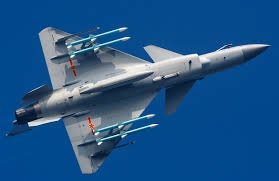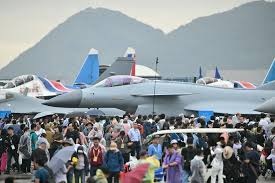Indonesia has sent shockwaves across Asia with the confirmation of a massive military acquisition from China. The purchase of a substantial fleet of Chengdu J-10 fighter jets, valued at an estimated $9 billion, represents the nation’s largest-ever single military acquisition and marks its inaugural major order for Chinese military hardware. This move has immediately fueled intense speculation across regional capitals: Is this a purely strategic modernization effort by Jakarta, or does it signal a calculated escalation of China’s economic and military influence throughout Southeast Asia?
The landmark deal was confirmed by Jakarta this week, positioning Indonesia as only the second foreign operator of the J-10 fighter jet, following its long-standing deployment by Pakistan. The purchase arrives amidst Indonesia’s existing commitments to diversify its air force fleet with high-profile Western assets, including the Boeing F-15EX, the Dassault Rafale, and investments in the Fifth-Generation Turkish KAAN Fighter program. The strategy appears to be a multi-pronged approach to fleet modernization, but the sheer scale of the Chinese deal gives pause to military analysts across the Indo-Pacific.

The Scale of the Acquisition
Indonesian Defense Minister Safri Samsudin confirmed the $9 billion acquisition this week, stating that the J-10s would be operational in Jakarta “as soon as possible.” While specific details remain tightly controlled, Deputy Finance Minister Suparba Yudha indicated that the arrangement could involve up to 12 J-10 fighter jets, poised to join the country’s rapidly modernizing air force.
The deal’s financing reveals the substantial commitment, with the Indonesian Ministry of Finance securing up to $1.6 billion in foreign loans for the initial phase. A letter from the Ministry of Finance reportedly specifies that the funding will be allocated for the J-10B variant. This designation is critical; the J-10B represents a significant upgrade over the basic J-10 model but crucially lacks the advanced systems, particularly the sophisticated Active Electronically Scanned Array (AESA) radar, found in the top-tier J-10C model.
The package is expected to be comprehensive, likely including advanced armament systems necessary for operational readiness. These armaments are anticipated to feature China’s latest air-to-air missiles, specifically the PL-10 (short-range), PL-12 (medium-range), and PL-15 (long-range) missile systems, ensuring the jets are immediately capable of modern air combat engagements.
The J-10’s Combat Proven Track Record
The decision to acquire the J-10 is heavily influenced by its recent performance in the hands of its only other foreign operator, Pakistan. Pakistan became the first export customer of the J-10, receiving its initial deliveries in 2022 to replace its aging Mirage fleet. Pakistan’s export variant utilizes an enhanced configuration featuring an ISA Radar, modern avionics, and the same high-caliber PL-10, PL-12, and PL-15 missile systems.
The J-10’s reputation received a significant boost following its deployment against the Indian Air Force earlier this year. In a widely reported engagement, Pakistani J-10s were reportedly involved in the downing of multiple Indian Rafale fighters. This marked the first instance of the J-10 being utilized in an active combat scenario, and its reported effectiveness—particularly considering its relative cost compared to Western counterparts—has bolstered its appeal in the global arms market. For Indonesia, the combat-proven status offers a compelling mix of capability and affordability that neatly fits its defense diversification strategy.
China’s Expanding Military Footprint
China’s emergence as a major global arms dealer is a critical geopolitical development. It currently ranks as the world’s fourth-largest military exporter, although nearly half of its exports historically have gone to its long-standing strategic ally, Pakistan. The J-10 deal with Indonesia—a key member of ASEAN and an economically powerful non-aligned state—signifies a major success in Beijing’s strategy to expand its defense industrial base and project influence beyond its traditional sphere.
The scale of China’s ambition is evident in previous negotiations, such as its reported talks with Iran for up to 150 J-10 fighter jets, a deal that ultimately fell through due to pricing disagreements. The successful Indonesian deal, however, demonstrates Beijing’s capacity to offer financially attractive and politically expedient packages to nations keen to avoid complete reliance on Western arms suppliers.
The Philippines: A Geopolitical Chess Move?
Perhaps the most significant consequence of the Indonesian deal is the ripple effect it is having on the highly contested geopolitical dynamic within the South China Sea. Following the announcement of the Indonesian acquisition, China’s state-owned media, The Global Times, published an article suggesting that Beijing is open to extending a similar fighter jet deal to the Philippines, despite the ongoing maritime tensions between the two nations in the West Philippine Sea and the South China Sea.
The article indicated that China is prepared to offer the Philippines a “good deal” on fighter jets, echoing the favorable terms reportedly given to Indonesia. This offer, however, is being viewed with extreme skepticism by regional defense experts and political analysts, who suggest that such a deal would inevitably come with significant, unspoken geopolitical conditions.
Defense experts speculate that the prerequisite for such a generous offer would involve Manila making strategic concessions in the disputed waters. The focus would likely center on easing the Philippines’ assertive posture concerning three of the most contentious flashpoints: Pag-asa Island (Thitu Island), Scarborough Shoal (Buscador Shoal), and Bajo de Masinloc (Scarborough Shoal).
In a highly symbolic gesture, the Chinese media report suggested that the proposal could include the provision of two J-10 aircraft free of charge, intended as a demonstration of China’s commitment to “friendship” despite recent maritime confrontations involving Philippine vessels in the West Philippine Sea.

Manila’s Firm Stance
The response from the Philippines’ defense establishment has been swift and firm. The Armed Forces of the Philippines (AFP) has confirmed that it has received no formal offer regarding the fighter jets from China. More importantly, the agency has reiterated its unwavering commitment to sourcing all its military requirements—for the Philippine Air Force, Navy, and Coast Guard—exclusively from its long-standing treaty allies and trusted partners.
This decision is rooted in the government’s comprehensive self-defense posture and its ongoing efforts to modernize the AFP. By remaining resolute in its procurement strategy, the Philippines is signaling a clear priority: the maintenance of strong, existing alliances, particularly with the United States and other Western nations, even when faced with the lure of politically charged, financially attractive military hardware packages from Beijing.
Indonesia’s purchase of the J-10 jets is more than just a multi-billion dollar arms deal; it is a seismic geopolitical event. It highlights the growing military capability and sales ambition of China, introduces a potent new player into Southeast Asia’s power balance, and forces neighboring nations, like the Philippines, to critically re-evaluate the complex matrix of security, diplomacy, and sovereignty in a rapidly changing regional landscape. The Marines of the South China Sea remain the high-stakes arena where the consequences of such acquisitions will ultimately be judged.





